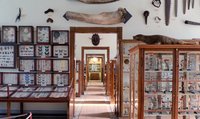Auf dem Foto ist der sogenannte Gebel es-Silsileh zu sehen. Hierbei handelt es sich um einen Steinbruch. Er liegt nördlich von Assuan, also in Oberägypten. Er war der wichtigste Ort zur Gewinnung von Sandstein im Alten Ägypten. Das liegt vor allem an seiner Prominenten Lage aber auch an der Qualität des dortigen Materials. Sowohl am West- als auch am Ostufer des Nils erstrecken sich die großen Felsformationen, die diesen Ort bilden. Sie schnüren den großen Fluss zusammen und zeigen ein ganz anderes Bild von dem Gewässer, das ansonsten von Fruchtland umgeben durch Ägypten fließt.
Das Foto stammt höchstwahrscheinlich von Félix Bonfils (1831-1885). Das geht aus der Bildaufschrift hervor (siehe unten). Er arbeitete viel im Nahen Osten, war aber auch in Ägypten unterwegs.
Das Foto besitzt unten links und rechts Aufschriften:
Links - "Gebel Silsileh. (Égypte). 177."
Rechts - "Bonfils."
Auf der Rückseite sind Bleistiftnotizen:
"rechts
1 Jahr Merneptah
links
am 1 Jahre v. Ramses II."
en

